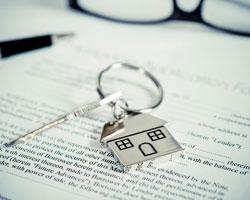Loan Documents and Mortgages
Mortgage Documents
 A mortgage involves two important legal documents: a promissory note and either a mortgage document or deed of trust.
A mortgage involves two important legal documents: a promissory note and either a mortgage document or deed of trust.
The Promissory Note
The promissory note (also called a mortgage note or real estate note) is a note the buyer gives to the lender promising to repay the amount of the loan plus interest. The note also states the amount of time the buyer has to repay the loan and what action the lender may take if the buyer fails to make the required payments. The note should state the interest rate and specify whether it is fixed or variable. The note also may contain provisions such as a balloon payment.
It is important to note that the borrower’s typical monthly payment to the lender is not solely for principal and interest owed on the note. Monthly payments might also include escrow payments for property taxes and insurance.
The Mortgage Document or Deed of Trust
The borrower gives the lender either a mortgage document or a deed of trust, depending on the state where the transaction takes place. Both serve the same purposes: as a pledge of the borrower’s title to the property as security for the loan; and as the basis for a legal claim against the property in the event of default. A mortgage document and a deed of trust have a few key differences:
- Mortgage Document: A mortgage document is used in most states. A mortgage involves only two parties: the borrower and the lender. It creates a lien on the property, which is recorded in the public land records. With a mortgage, the borrower has full title to the property but may not transfer ownership until the debt is paid off and the lien is released. If the debt is not paid, the lender has the right to sell the property, usually through udicial foreclosure.
- Deed of Trust: Many states, including California and Texas, use a deed of trust instead of a mortgage. The deed of trust is recorded in the public records to give notice that the property has a lien on it. A deed of trust involves three parties: the borrower, the lender and a third-party trustee, such as an attorney or title insurance company, who holds temporary title until the debt is paid and the deed of trust is cancelled. If the debt is not paid, the trustee may sell the property. The lender must give the trustee proof that the debt is delinquent and ask the trustee to foreclose. Foreclosure typically bypasses the court system.
Qualifying for a Mortgage
To obtain a mortgage, a borrower first must qualify for the loan. Most lenders require a debt-to-income ratio of 28/36. This means that no more than 28 percent of the borrower’s income may go toward the mortgage payments and no more than 36 percent may go toward the mortgage payment and all other outstanding debts. Once the borrower meets this requirement, most lenders require the buyer to make a down payment on the loan. The amount of the down payment varies depending on a number of factors, such as income and credit history. The riskier the lender considers the loan to be, however, the higher the down payment is likely to be.
One option for borrowers who cannot afford a large down payment is an FHA loan. For this type of loan, the Federal Housing Administration allows borrowers to make a small down payment and then guarantees the lender that it will pay the loan if the borrower defaults. Almost anyone can qualify for an FHA loan, but the FHA limits how much may be borrowed.
Borrowers with a credit score below 660 may also qualify for a subprime mortgage. Subprime mortgages have higher interest rates than those given to “prime” borrowers.
Second Mortgages
Generally, second mortgages come in the form of a home-equity loan, in which the borrower uses the equity in his or her house as collateral. Just like in a first mortgage, a lien is created against the borrower’s property. A lien is simply a legal claim that the lender has in case the borrower defaults. While second mortgages are common, it is rare that a borrower could get a third or fourth mortgage on the same property. Additionally, second mortgages tend to come with higher interest rates because the loan is riskier for the lender.
A problem with multiple mortgages arises when the borrower defaults on one or both loans. If that happens, the first lien holder (the first lender) has priority over the second lien holder (the second lender) and may initiate foreclosure proceedings. The first lender has a right to all of the money due under the mortgage contract. This is true even if the borrower continues to pay on the first mortgage but defaults on the second. While the second lender may foreclose on the house, the first lender still has priority.
What is a Mortgage?
For most people, the purchase of a home is the largest single investment of their life. Because few people have the financial resources to pay cash for a home, most obtain a loan through a bank or finance company. To protect its investment, the bank or finance company will typically secure the note with a mortgage.
Technically, the mortgage is the legal document that establishes a collateral relationship between the money loaned and the real property purchased. If the purchase fails to make payments as set forth in the note, the lender has the right to pursue foreclosure according to the terms of the mortgage. Typically, this involves taking possession of the property, selling the property at a foreclosure sale, and applying the proceeds of the sale to the balance owed on the note. Though all the terms of repayment are typically found in the note, as a practical matter, the term mortgage is used to refer to the combined “note-security instrument”.
The Different Types of Mortgages
There are two basic types of mortgages: fixed rate and adjustable rate. Fixed-rate mortgages are the most common, with the principal (the actual cost of the house) and the interest rate remaining the same over the life of the loan.
Conversely, an adjustable-rate mortgage (ARM) is based on some external index, such as the prime lending rate. Accordingly, the interest rate on an ARM fluctuates depending on that index. In times of economic uncertainty, or if a borrower has some credit challenges, the lender may demand that the parties enter into a balloon mortgage. A balloon mortgage has a fixed interest rate typically lower than any other type of mortgage.
After a certain time (usually between five and seven years), the loan payments will “balloon,” requiring the borrower to pay off the entire balance of the loan. This type of mortgage is not attractive to home buyers unless they make a substantial down payment, plan to refinance the mortgage or plan to sell the home before the balloon payment is due. A balloon mortgage is risky because if the borrower cannot pay off the balloon payment, he or she risks foreclosure.
Connect with Top-rated Attorneys Near You
Sponsored Advertisement
Other Real Estate Law Topics
Understanding Real Estate Lease Agreements
Loan Questions
Oil, Gas, and Mineral Rights in Real Estate Transactions
Real Estate Closing
An Overview of Real Estate Contracts
Real Estate Law Resources
Subprime/Nonprime Mortgages—An Overview
The Function and Value of Title Insurance
Transfer of Ownership
Water Law
Zoning and Land Use
Understanding Construction Contracts
Latest Article
What Is an Easement?
How Does It Affect Your Property Rights? What Are the Different Types of Easements? How Do You Get an Easement? When yo... Read More
What Is an Easement?
How Do You Get an Easement? When Do You Need One? The purchase of real property conveys many rights You have the r... Read More
What Is Adverse Possession?
How Does Adverse Possession Affect Property Ownership? One way that property owners exercise their property rights is b... Read More
GETLEGAL®ATTORNEY DIRECTORY
Find Leading Attorneys in Your Area
NEED PROFESSIONAL HELP?
Talk to an Attorney
How It Works
- Briefly tell us about your case
- Provide your contact information
- Choose attorneys to contact you





